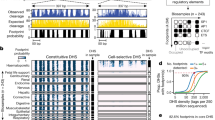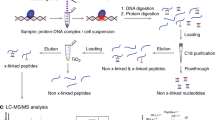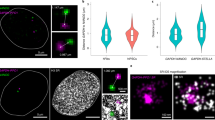Abstract
A major goal in biomedical research is to determine the mechanisms responsible for gene regulation. However, the promoters and operators that control transcription are often complex in nature, containing multiple-binding sites with which DNA-binding proteins can interact cooperatively. Quantitative DNase footprint titration is one of the few techniques capable of resolving the microscopic binding affinities responsible for the macroscopic assembly process. Here, we present a step-by-step protocol for carrying out a footprint titration experiment. We then describe how to quantify the resultant images to generate individual-site binding curves. Finally, we derive basic equations for binding at each site and present an overview of the fitting process, applying it to the anticipated results. Users should anticipate that the footprinting experiment will take 3–5 d starting from DNA template isolation to image acquisition and quantitation.
This is a preview of subscription content, access via your institution
Access options
Subscribe to this journal
Receive 12 print issues and online access
$259.00 per year
only $21.58 per issue
Buy this article
- Purchase on Springer Link
- Instant access to full article PDF
Prices may be subject to local taxes which are calculated during checkout







Similar content being viewed by others
References
Galas, D.J. & Schmitz, A. DNase footprinting: a simple method for the detection of protein-DNA binding specificity. Nucleic Acids Res. 5, 3157–3170 (1978).
Johnson, A.D., Meyer, B.J. & Ptashne, M. Interactions between DNA-bound repressors govern regulation by the λ phage repressor. Proc. Natl. Acad. Sci. USA 76, 5061–5065 (1979).
Ptashne, M. A Genetic Switch: Gene Control and Phage λ (Cell Press and Blackwell Scientific Publications, Cambridge, MA, 1986).
Brenowitz, M., Senear, D.F., Shea, M.A. & Ackers, G.K. Quantitative DNase footprint titration: a method for studying protein-DNA interactions. Methods Enzymol. 130, 132–181 (1986).
Brenowitz, M., Senear, D.F., Shea, M.A. & Ackers, G.K. 'Footprint' titrations yield valid thermodynamic isotherms. Proc. Natl. Acad. Sci. USA 83, 8462–8466 (1986).
Ackers, G.K., Johnson, A.D. & Shea, M.A. Quantitative model for gene regulation by λ phage repressor. Proc. Natl. Acad. Sci. USA 79, 1129–1133 (1982).
Koblan, K.S. & Ackers, G.K. Cooperative protein-DNA interactions: effects of KCl on λ cI binding to OR . Biochemistry 30, 7822–7827 (1991).
Koblan, K.S. & Ackers, G.K. Site-specific enthalpic regulation of DNA transcription at bacteriophage λ OR . Biochemistry 31, 57–65 (1992).
Senear, D.F. & Ackers, G.K. Proton-linked contributions to site-specific interactions of λ cI repressor and OR . Biochemistry 29, 6568–6577 (1990).
Chahla, M., Wooll, J., Laue, T.M., Nguyen, N. & Senear, D.F. Role of protein-protein bridging interactions on cooperative assembly of DNA-bound CRP-CytR-CRP complex and regulation of the Escherichia coli CytR regulon. Biochemistry 42, 3812–3825 (2003).
Connaghan-Jones, K.D., Heneghan, A.F., Miura, M.T. & Bain, D.L. Thermodynamic analysis of progesterone receptor-promoter interactions reveals a molecular model for isoform-specific function. Proc. Natl. Acad. Sci. USA 104, 2187–2192 (2007).
Petri, V., Hsieh, M., Jamison, E. & Brenowitz, M. DNA sequence-specific recognition by the Saccharomyces cerevisiae 'TATA' binding protein: promoter-dependent differences in the thermodynamics and kinetics of binding. Biochemistry 37, 15842–15849 (1998).
Streaker, E.D., Gupta, A. & Beckett, D. The biotin repressor: thermodynamic coupling of corepressor binding, protein assembly, and sequence-specific DNA binding. Biochemistry 41, 14263–14271 (2002).
Hsieh, M. & Brenowitz, M. Quantitative kinetics footprinting of protein-DNA association reactions. Methods Enzymol. 274, 478–492 (1996).
Pray, T.R., Burz, D.S. & Ackers, G.K. Cooperative non-specific DNA binding by octamerizing λ cI repressors: a site-specific thermodynamic analysis. J. Mol. Biol. 282, 947–958 (1998).
Sclavi, B., Sullivan, M., Chance, M.R., Brenowitz, M. & Woodson, S.A. RNA folding at millisecond intervals by synchrotron hydroxyl radical footprinting. Science 279, 1940–1943 (1998).
Eftink, M.R. Use of fluorescence spectroscopy as thermodynamics tool. Methods Enzymol. 323, 459–473 (2000).
Velázquez-Campoy, A., Ohtaka, H., Nezami, A., Muzammil, S. & Freire, E. Isothermal titration calorimetry. In Current Protocols in Cell Biology (eds. Bonifacino, J. S. et al.) 17.8 (John Wiley & Sons, New York, 2004).
Fried, M. & Crothers, D.M. Equilibria and kinetics of lac repressor-operator interactions by polyacrylamide gel electrophoresis. Nucleic Acids Res. 9, 6505–6525 (1981).
Garner, M.M. & Revzin, A. A gel electrophoresis method for quantifying the binding of proteins to specific DNA regions: application to components of the Escherichia coli lactose operon regulatory system. Nucleic Acids Res. 9, 3047–3060 (1981).
Tanious, F.A., Nguyen, B. & Wilson, W.D. Biosensor-surface plasmon resonance methods for quantitative analysis of biomolecular interactions. Methods Cell Biol. 84, 53–77 (2008).
Hellman, L.M. & Fried, M.G. Electrophoretic mobility shift assay (EMSA) for detecting protein-nucleic acid interactions. Nat. Protoc. 2, 1849–1861 (2007).
Brenowitz, M., Senear, D.F. & Ackers, G.K. Flanking DNA-sequences contribute to the specific binding of cI-repressor and OR1. Nucleic Acids Res. 17, 3747–3755 (1989).
Senear, D.F., Dalma-Weiszhausz, D.D. & Brenowitz, M. Effects of anomalous migration and DNA to protein ratios on resolution of equilibrium constants from gel mobility-shift assays. Electrophoresis 14, 704–712 (1993).
Carruthers, L.M., Schirf, V.R., Demeler, B. & Hansen, J.C. Sedimentation velocity analysis of macromolecular assemblies. Methods Enzymol. 321, 66–80 (2000).
Laue, T.M. Sedimentation equilibrium as thermodynamic tool. Methods Enzymol. 259, 427–452 (1995).
Valdes, R. Jr & Ackers, G.K. Study of protein subunit association equilibria by elution gel chromatography. Methods Enzymol. 61, 125–142 (1979).
Heneghan, A.F., Berton, N., Miura, M.T. & Bain, D.L. Self-association energetics of an intact, full-length nuclear receptor: the B-isoform of human progesterone receptor dimerizes in the micromolar range. Biochemistry 44, 9528–9537 (2005).
Maluf, N.K., Fischer, C.J. & Lohman, T.M. A dimer of Escherichia coli UvrD is the active form of the helicase in vitro. J. Mol. Biol. 325, 913–935 (2003).
Daugherty, M.A., Brenowitz, M. & Fried, M.G. Participation of the amino-terminal domain in the self-association of the full-length yeast TATA binding protein. Biochemistry 39, 4869–4880 (2000).
Laskey, R.A. & Mills, A.D. Enhanced autoradiographic detection of 32P and 125I using intensifying screens and hypersensitized film. FEBS Lett. 82, 314–316 (1977).
Connaghan-Jones, K.D., Heneghan, A.F., Miura, M.T. & Bain, D.L. Thermodynamic dissection of progesterone receptor interactions at the mouse mammary tumor virus promoter: Monomer binding and strong cooperativity dominate the assembly reaction. J. Mol. Biol. 377, 1144–1160 (2008).
Heneghan, A.F., Connaghan-Jones, K.D., Miura, M.T. & Bain, D.L. Cooperative DNA binding by the B-isoform of human progesterone receptor: thermodynamic analysis reveals strongly favorable and unfavorable contributions to assembly. Biochemistry 45, 3285–3296 (2006).
Heneghan, A.F., Connaghan-Jones, K.D., Miura, M.T. & Bain, D.L. Coactivator assembly at the promoter: efficient recruitment of SRC2 is coupled to cooperative DNA binding by the progesterone receptor. Biochemistry 46, 11023–11032 (2007).
Riggs, A.D., Bourgeois, S., Newby, R.F. & Cohn, M. DNA binding of the lac repressor. J. Mol. Biol. 34, 365–368 (1968).
Senear, D.F., Brenowitz, M., Shea, M.A. & Ackers, G.K. Energetics of cooperative protein-DNA interactions: comparison between quantitative deoxyribonuclease footprint titration and filter binding. Biochemistry 25, 7344–7354 (1986).
Das, R., Laederach, A., Pearlman, S.M., Herschlag, D. & Altman, R.B. SAFA: semi-automated footprinting analysis software for high-throughput quantification of nucleic acid footprinting experiments. RNA 11, 344–354 (2005).
Hill, T.L. An Introduction to Statistical Thermodynamics (Dover Publications, New York, 1960).
Johnson, M.L. Why, when, and how biochemists should use least squares. Anal. Biochem. 206, 215–225 (1992).
Koblan, K.S., Bain, D.L., Beckett, D., Shea, M.A. & Ackers, G.K. Analysis of site-specific interaction parameters in protein-DNA complexes. Methods Enzymol. 210, 405–425 (1992).
Trauger, J.W. & Dervan, P.B. Footprinting methods for analysis of pyrrole-imidazole polyamide/DNA complexes. Methods Enzymol. 340, 450–466 (2001).
Ozoline, O.N. & Tsyganov, M.A. Structure of open promoter complexes with Escherichia coli RNA polymerase as revealed by the DNase I footprinting technique: compilation analysis. Nucleic Acids Res. 23, 4533–4541 (1995).
Strahs, D. & Brenowitz, M. DNA conformational changes associated with the cooperative binding of cI-repressor of bacteriophage λ to OR . J. Mol. Biol. 244, 494–510 (1994).
Sclavi, B., Woodson, S., Sullivan, M., Chance, M.R. & Brenowitz, M. Time-resolved synchrotron X-ray 'footprinting', a new approach to the study of nucleic acid structure and function: application to protein-DNA interactions and RNA folding. J. Mol. Biol. 266, 144–159 (1997).
Petri, V., Hsieh, M. & Brenowitz, M. Thermodynamic and kinetic characterization of the binding of the TATA binding protein to the adenovirus E4 promoter. Biochemistry 34, 9977–9984 (1995).
Pastor, N., Weinstein, H., Jamison, E. & Brenowitz, M. A detailed interpretation of OH radical footprints in a TBP-DNA complex reveals the role of dynamics in the mechanism of sequence-specific binding. J. Mol. Biol. 304, 55–68 (2000).
Connaghan-Jones, K.D., Heneghan, A.F., Miura, M.T. & Bain, D.L. Hydrodynamic analysis of the human progesterone receptor A-isoform reveals that self-association occurs in the micromolar range. Biochemistry 45, 12090–12099 (2006).
Acknowledgements
This work was supported by National Institutes of Health, USA grant R01-DK061933 to D.L.B.
Author information
Authors and Affiliations
Corresponding author
Rights and permissions
About this article
Cite this article
Connaghan-Jones, K., Moody, A. & Bain, D. Quantitative DNase footprint titration: a tool for analyzing the energetics of protein–DNA interactions. Nat Protoc 3, 900–914 (2008). https://doi.org/10.1038/nprot.2008.53
Published:
Issue Date:
DOI: https://doi.org/10.1038/nprot.2008.53
This article is cited by
-
An ancient protein-DNA interaction underlying metazoan sex determination
Nature Structural & Molecular Biology (2015)
-
Advances in the study of protein–DNA interaction
Amino Acids (2012)
Comments
By submitting a comment you agree to abide by our Terms and Community Guidelines. If you find something abusive or that does not comply with our terms or guidelines please flag it as inappropriate.



